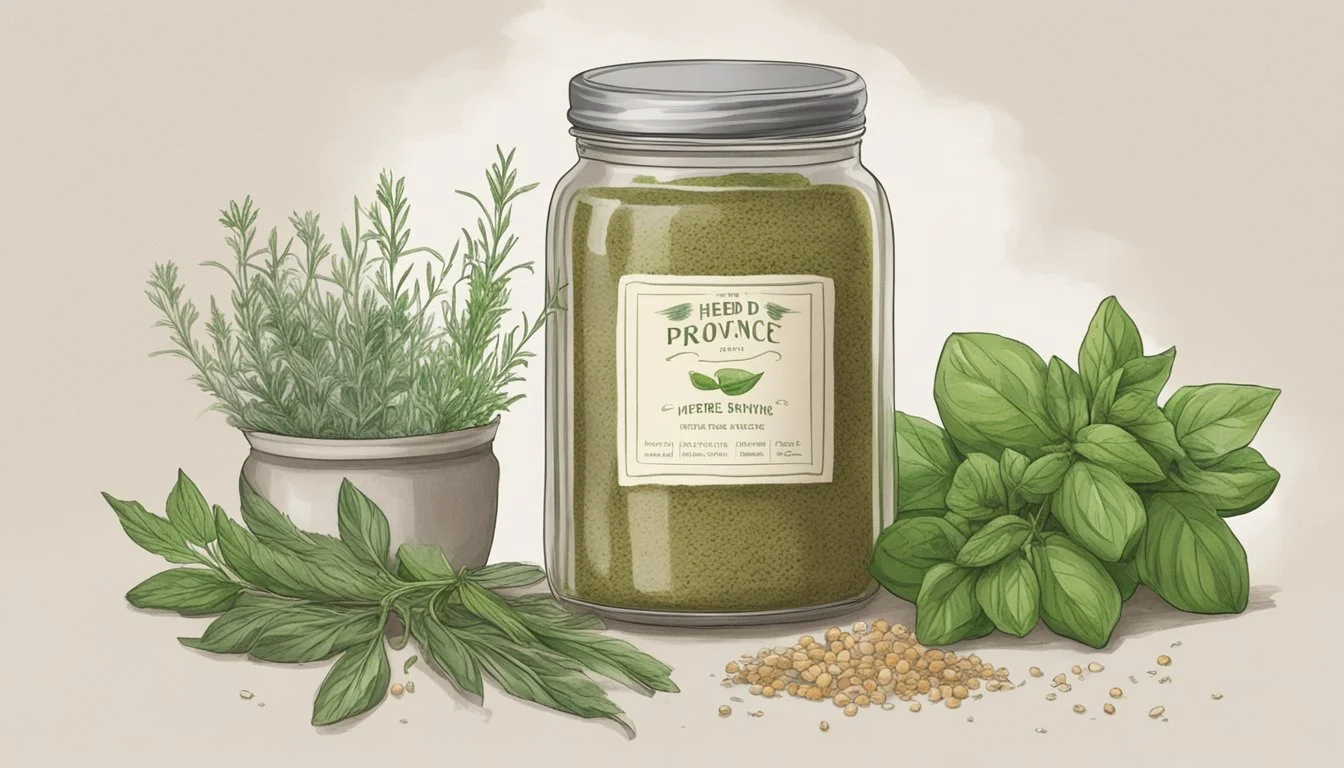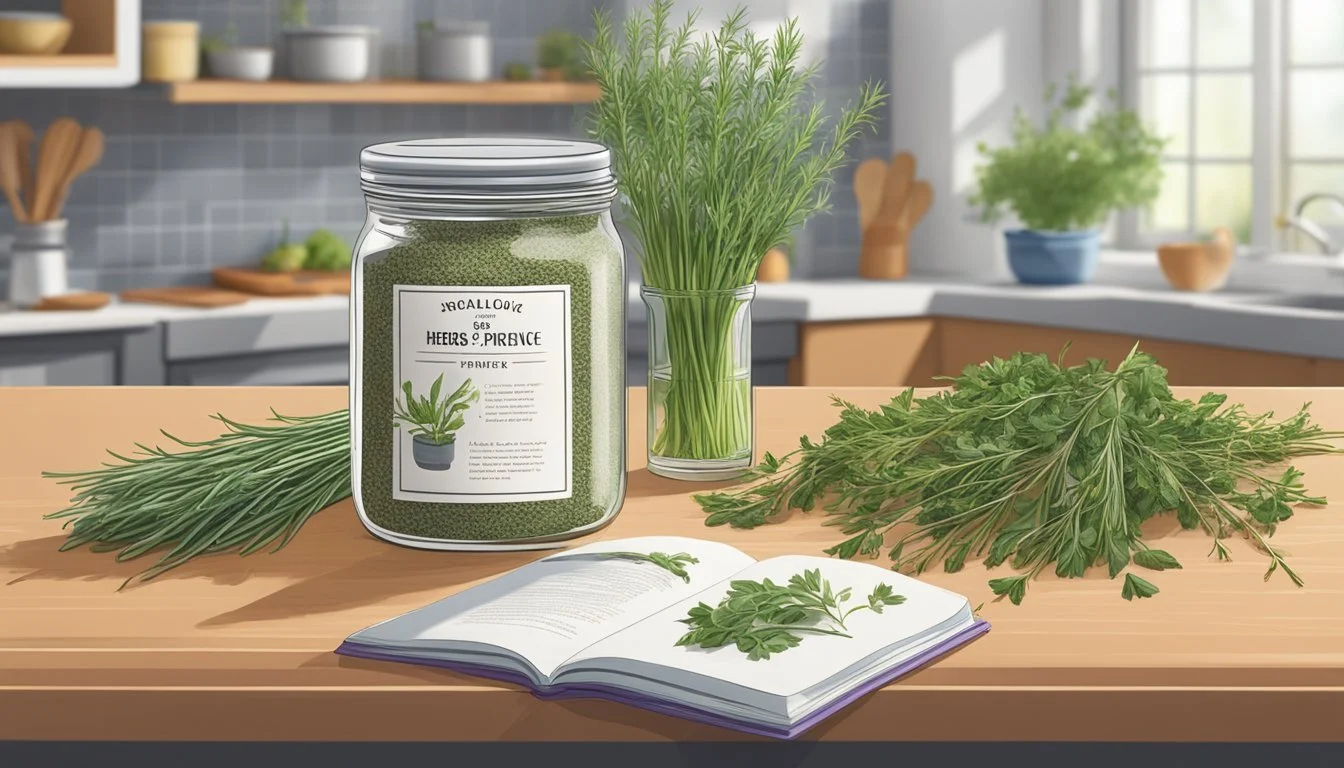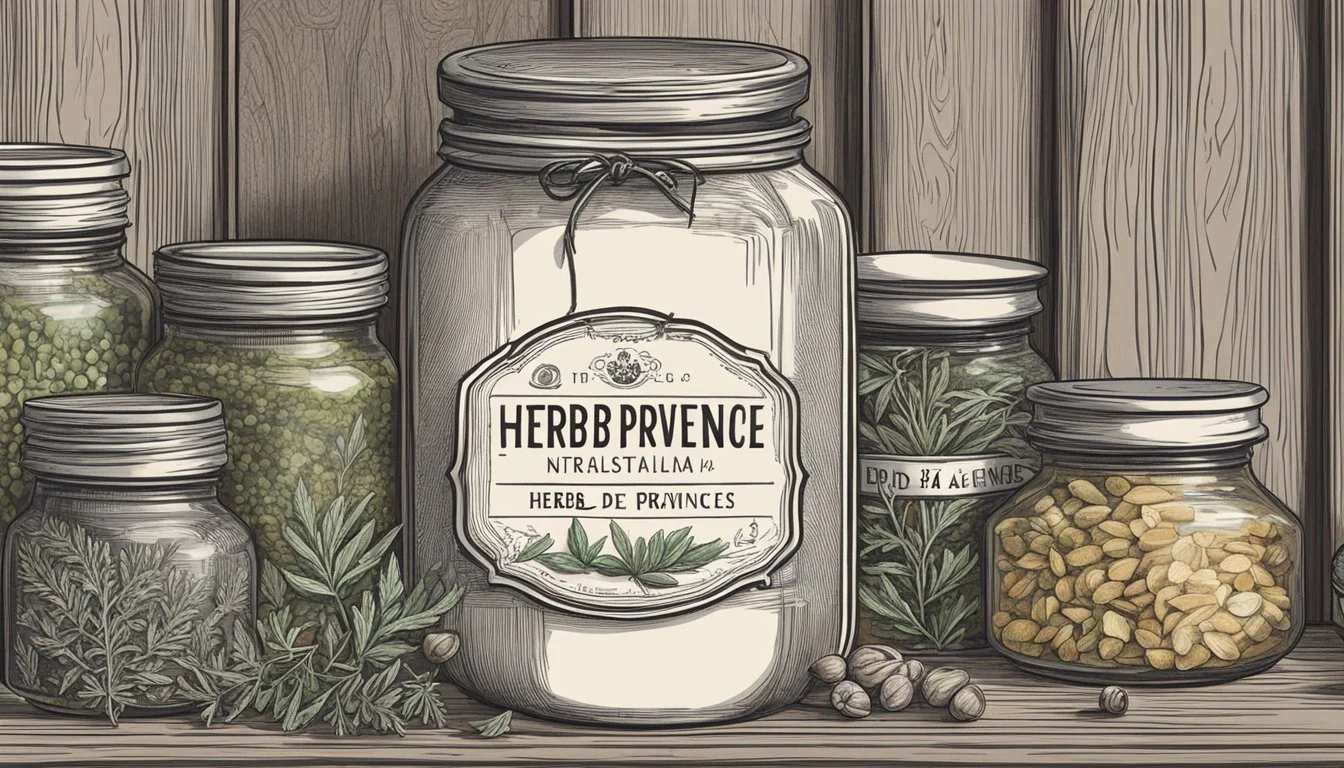Does Herb de Provence Go Bad?
Shelf Life and Storage Tips
Herbes de Provence, like most dried herbs, can lose potency over time, although they don't exactly "go bad" in the way fresh produce does. This blend, originating from the Provence region in France, is prized for its aromatic and flavorful contribution to various dishes. Typically, the mix includes thyme, rosemary, oregano, and sometimes lavender, imbued with the essence of southern France.
When stored properly, Herbes de Provence can maintain their peak flavor for about one to two years. After this period, while they remain safe to use, the herbs may not impart as robust a taste as fresher blends. For the best culinary experience, storing the herbs in a cool, dark place in an airtight container is essential.
Herb enthusiasts often test the potency of Herbes de Provence by crushing a small amount in their fingers and checking for a strong aroma. Should the scent seem faint, it’s likely time to refresh the supply. Regularly updating one's herb collection ensures that dishes remain as vibrant and flavorful as intended.
Understanding Herbes De Provence
Herbes de Provence is a distinctive blend that heralds from the Provence region of France. It is commonly used in French cuisine to impart rich, aromatic flavors to various dishes.
Origin and Culinary Use
Herbes de Provence has its roots in the Provence region, a place known for its aromatic herbs and vibrant agriculture. The mix became popular in the 1960s when it was formalized into a commercial product. It gained further attention when Julia Child showcased it in her cookbook Mastering the Art of French Cooking.
In culinary applications, the blend is versatile. It is often used to season poultry, lamb, and fish. Additionally, it enhances robust stews, marinades goat cheeses, and can be sprinkled over roasted vegetables. Its pungent aroma and potent flavor profile make it an excellent choice for various French dishes.
Typical Ingredients and Variations
The traditional composition of Herbes de Provence generally includes rosemary, thyme, oregano, savory, and marjoram. Lavender is sometimes included, adding a unique floral note that differentiates it from other herb blends.
There are various versions of the mix. Commercial brands often add fennel and basil, and the exact ingredients can differ from one producer to another. Despite the variations, the core herbs remain consistent, maintaining the blend's characteristic taste profile.
Provençal cuisine relies heavily on this herb mixture due to its robust and aromatic qualities. It binds the flavors of meats, cheeses, and locally grown vegetables, creating a harmonious balance in the dish.
The Shelf Life of Dried Herbs
Dried herbs, including Dried Thyme, Dried Rosemary, Dried Oregano, and others, can last anywhere from several months to a few years. Factors like type of herb and storage conditions significantly influence their longevity.
Factors Affecting Freshness
Several elements impact the shelf life of dried herbs. The type of herb is crucial; for instance, Dried Thyme and Dried Rosemary generally last longer than more delicate herbs like Dried Lavender Flowers. The processing method matters too. Home-dried herbs might only stay fresh for 6-12 months, while commercially dried herbs can maintain their flavor for 2-3 years.
Proper storage conditions are essential. Keep herbs in a cool, dark place to maintain freshness. Tightly sealed containers prevent moisture, heat, and light from reducing their quality. Storing herbs in the pantry can help avoid exposure to direct sunlight or humidity, preserving their aromatic qualities.
Signs of Aging
Identifying aged dried herbs is crucial for maintaining optimal flavor. Herbs lose potency over time, which affects their Flavor Profile. Faded color is a clear sign of aging. For example, Dried Oregano and Dried Marjoram may turn dull green or brownish.
Other signs include a reduction in aroma and flavor. If Fresh Herbs no longer have a strong scent, they have likely aged. Textural changes can also indicate aging; herbs that turn brittle or powdery are no longer at their peak freshness. Regularly checking your herb collection can help ensure you're using the most flavorful and aromatic ingredients.
Proper Storage Techniques
To extend the shelf life of Herbs de Provence, proper storage is crucial. The key aspects involve using suitable containers and maintaining ideal storage conditions.
Choosing the Right Container
Using an airtight container is essential to preserve the flavor and aroma of Herbs de Provence. Glass jars with tight-sealing lids are highly recommended. These containers prevent moisture and air from spoiling the herbs.
Plastic containers can also be used if they are high-quality and BPA-free. Ensure that all containers are thoroughly cleaned and dried before storing any herbs to avoid contamination. Using small containers can minimize the amount of air in contact with the herbs, thus better preserving their quality.
Ideal Storage Conditions
Herbs de Provence should be stored in a cool, dark location such as a pantry or spice rack placed away from heat sources like stoves and ovens. Exposure to heat and light can degrade the herbs' quality.
Always avoid storing herbs near windows where sunlight can cause harmful UV exposure. Maintaining a low-humidity environment is also vital, so avoid storage areas like above the dishwasher where steam may reach. If multiple herbs are stored in the same area, labeling each container helps ensure quick access without prolonged exposure to air.
Culinary Applications
Herbes de Provence is an aromatic blend of dried herbs that adds depth and sophistication to various culinary dishes, from meats and poultry to vegetables, soups, stews, and sauces.
Enhancing Meat and Poultry
Herbes de Provence enhances the flavor of meats and poultry, bringing a taste of the French countryside to the table. Chicken and other poultry benefit significantly from this blend when used in roasting or grilling.
For instance, coating a whole chicken with olive oil and Herbes de Provence before roasting creates a fragrant and flavorful crust. Fish and other seafood like salmon also pair well with this blend, especially when grilled.
This combination turns ordinary dishes into gourmet experiences through the rich interplay of thyme, rosemary, and other herbs.
Vegetables and Side Dishes
Herbes de Provence excels in elevating vegetables and side dishes. Roasted potatoes become aromatic delights when tossed in olive oil and this blend of herbs.
Ratatouille, a traditional Provençal vegetable dish, relies heavily on these herbs to achieve its signature flavor. Adding Herbes de Provence to stir-fried or roasted veggies, such as zucchini, bell peppers, and eggplant, brings out their natural sweetness and adds a robust herbal note.
Sprinkling the herbs on breads and dressings can also infuse everyday sides with a touch of elegance.
Soups, Stews, and Sauces
Soups, stews, and sauces are other canvases where Herbes de Provence shines. Adding this blend to soups like vegetable or chicken soup provides a comforting, earthy aroma.
It complements hearty stews, enhancing the complexity of both meat and vegetable bases. The herbs also integrate well into sauces, such as tomato-based or creamy sauces for pasta, adding layers of herbal flavor.
A spoonful of Herbes de Provence in salad dressings and marinades can also elevate the taste of fresh greens, turning simple dressings into aromatic delights.
Herbes De Provence in Recipes
Herbes de Provence is a versatile seasoning blend that enhances a wide array of dishes. This aromatic mix often includes ingredients like thyme, marjoram, savory, rosemary, and basil.
Traditional Provencal Recipes
Traditional Provencal recipes rely heavily on Herbes de Provence for their earthy and aromatic qualities. Ratatouille, a classic vegetable stew, benefits from the seasoning’s blend of thyme, rosemary, and savory.
Bouillabaisse, a seafood stew, uses the herbs to complement the briny flavors of the sea. Roast lamb often contains Herbes de Provence, infusing the meat with its fragrant profile. Olive oil, another staple in Provence, combines well with these herbs during the cooking process.
Modern Twists and Variations
Modern recipes have embraced Herbes de Provence, offering innovative takes on classical dishes. Herbes de Provence Chicken is a popular contemporary recipe where chicken thighs are seasoned with the herb blend for a flavorful crust.
Herb-infused bread makes use of the seasoning blend in the dough, creating a fragrant loaf. Grilled vegetables are enhanced by the addition of these herbs, providing a sophisticated edge to a simple dish. Experimenting with Herbes de Provence in soups and stews can lead to delightful discoveries.
DIY Herb Blends
Creating a DIY Herbes de Provence blend allows for customization tailored to personal taste. Common ingredients include:
1 tablespoon dried savory
1 tablespoon dried marjoram
1 tablespoon dried rosemary or lavender
1 tablespoon dried thyme
1 tablespoon dried oregano
1 tablespoon dried basil
1 tablespoon dried tarragon
Optional additions might be 1 teaspoon dried bay leaf or other preferred herbs. Blending these at home ensures a fresh, potent mix and allows one to tailor the seasoning's balance, ensuring an ideal match for any recipe.
By following these guidelines, cooks can faithfully recreate traditional Provencal dishes or experiment with contemporary variations, always benefiting from the rich, aromatic profile that Herbes de Provence brings to the table.
Substitutes and Alternatives
When Herbes de Provence is unavailable, there are numerous viable replacements that can capture the intended flavor profile. Readers will benefit from knowing which individual herbs or combinations can serve as effective alternatives.
When Herbes De Provence Is Unavailable
Herbes de Provence can be substituted with several blends. Italian seasoning is a common choice and includes herbs like basil, oregano, and rosemary.
If precise replication is needed, a homemade blend can be crafted. Include thyme, rosemary, and oregano, and add lavender for authenticity.
Another substitute is Fines Herbes, comprising parsley, chives, tarragon, and chervil. This mix is more delicate but can serve in milder recipes.
Beyond these blends, Bouquet Garni, a traditional French mix of herbs often wrapped in a bundle, works well in stews and soups.
Individual Herb Substitutes and Ratios
To match the flavors of Herbes de Provence with individual herbs, combine the following:
Thyme: Foundational herb. Use a 1:1 ratio.
Rosemary: Provides robust flavor. Also a 1:1 ratio.
Oregano: Adds the Mediterranean touch. Match with a 1:1 ratio.
Tarragon: For a subtle anise flavor, use sparingly, about half the amount compared to thyme.
Savory: Another component, use a 1:1 ratio with thyme.
Basil: Occasionally added. 1:1 ratio consistent.
Fennel Seeds: Impart a mild spiciness. Add half the amount relative to thyme.
Herbes de Provence typically contains lavender flowers, which is optional but adds a unique aroma. Using these individual herbs and adjusting the ratios accordingly ensures the closest approximation. A balanced blend involving sage, garlic, and some black pepper can further enhance the overall flavor.
Health and Nutrition Aspects
Herbes de Provence offers numerous health benefits due to its mix of nutritious herbs while also posing some considerations for those with dietary restrictions.
Benefits of Using Dried Herbs
Herbes de Provence includes a variety of dried herbs like thyme, rosemary, oregano, marjoram, and savory. These herbs are rich in antioxidants, which can help protect the body from oxidative stress. They can also add flavor to dishes without the need for added salt, making them a good choice for those monitoring their sodium intake.
Additionally, these herbs are low in calories yet high in essential vitamins and minerals, contributing to overall nutritional wellbeing. For instance, rosemary and thyme contain vitamins A and C, and have anti-inflammatory properties which can assist in maintaining health. Using herbes de Provence in various recipes such as a vinaigrette or a meat rub can enhance both flavor and nutrition.
Considerations for Dietary Restrictions
While herbes de Provence is mostly beneficial, those with specific dietary restrictions need to be mindful. Individuals with allergies to specific herbs such as mint or parsley should check the blend carefully. Although traditional herbes de Provence doesn’t typically contain these, some blends might include additional herbs not originally from the Provence region.
Furthermore, for those on a low-sodium diet, it’s essential to ensure that pre-packaged blends don’t include added salt. Sodium intake can be managed by creating a homemade blend using dried herbs sourced from grocery stores. When using herbes de Provence in recipes like marinades or dishes involving white wine, consider the cumulative sodium content from all ingredients. This ensures the dietary needs and restrictions are adhered to effectively.
Buying and Quality Assessment
Selecting the right Herbes de Provence blend is critical for achieving authentic flavors in French and Provençal cuisine. Key factors include where to buy and how to assess its quality.
Where to Purchase Herbes de Provence
Herbes de Provence can be found in grocery stores, specialty spice shops, and online. Grocery stores often carry pre-packaged blends, but specialty shops may offer fresher and higher-quality options. Online sources vary widely in quality; reading customer reviews can help ensure you select a reputable seller.
To assess quality, check the freshness and fragrance. Fresh herbs should be aromatic. Packaging should be airtight to preserve the fragrance and minimize exposure to light and air, which can degrade the herbs. Avoid blends with additives or preservatives for the best French cooking experience.








